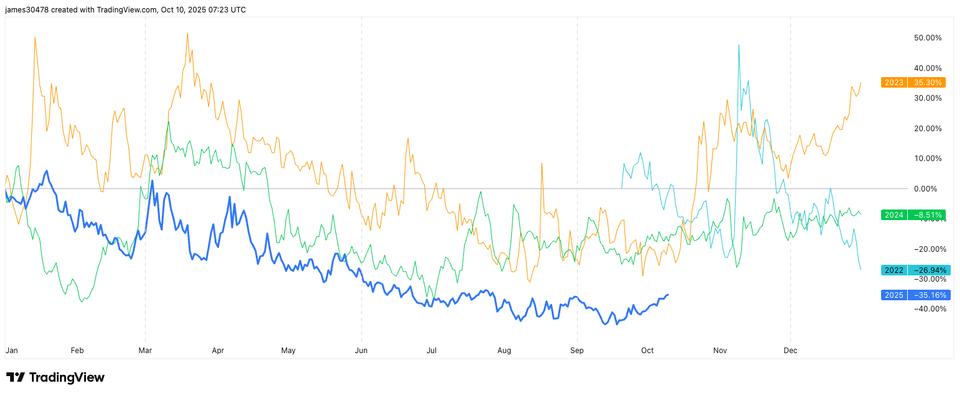Market Pulse
The cryptocurrency market is once again showing its characteristic dynamism, with Bitcoin’s implied volatility reaching multi-month highs. This surge in market expectation for price swings coincides with historical patterns of seasonal strength, particularly as the final quarter of the year often ushers in renewed bullish momentum for digital assets. For traders and investors, understanding this evolving volatility landscape is crucial for navigating potential opportunities and risks in the coming weeks, as the digital asset space gears up for what could be a pivotal period of price discovery.
Unpacking Implied Volatility’s Ascent
Implied volatility (IV) is a forward-looking metric derived from options prices, reflecting the market’s collective expectation of how much an asset’s price will move in the future. Recent data from derivatives markets indicates that Bitcoin’s 30-day implied volatility has climbed to levels not seen in over two months, signaling a departure from the relatively subdued price action observed in prior periods. This isn’t just a statistical blip; it signifies a collective anticipation among options traders of larger price fluctuations, suggesting a potential break from recent consolidation. Higher IV typically translates to more expensive options contracts across all strike prices and expiry dates, as the perceived likelihood of those contracts finishing “in the money” increases, prompting options writers to demand higher premiums for the added risk they assume.
Seasonal Strength and Q4 Expectations
The timing of this volatility surge is particularly noteworthy, aligning with historical trends that often see increased activity and price appreciation towards the end of the year. The term “Uptober” has gained colloquial recognition in crypto circles, referencing a tendency for Bitcoin to perform positively in October, often setting the stage for a stronger Q4. As we move deeper into this quarter, many analysts look to past cycles where robust capital inflows, driven by both retail and institutional investors, and renewed speculative interest have often propelled Bitcoin and the broader altcoin market higher. This seasonal tailwind, coupled with a backdrop of evolving macroeconomic factors such as fluctuating interest rate trajectories and inflation concerns, could be contributing significantly to the heightened expectations of future price movement. The interplay of these forces suggests a dynamic market environment ahead.
- Historically, the fourth quarter (Q4) has often been a strong period for Bitcoin’s price performance, demonstrating a seasonal tendency.
- Increased institutional interest and year-end portfolio rebalancing activities frequently accompany this period.
- Evolving macroeconomic narratives, such as central bank policies and global liquidity, continue to exert influence on crypto market sentiment.
- The growing maturity of crypto derivatives markets provides new avenues for expressing directional bets and hedging, amplifying volatility signals.
- Regulatory clarity or advancements, even minor ones, can also act as catalysts for market movement during these active periods.
Implications for Market Participants
For options traders, rising implied volatility presents both unique challenges and significant opportunities. Those holding long options positions (calls or puts) might see their premiums appreciate even without substantial spot price movement, simply due to increased market uncertainty and the “vega” component of option pricing. Conversely, options sellers, who profit from declining volatility, face greater risk and potential losses. For spot traders and longer-term investors, higher volatility implies the potential for rapid price discovery – whether upwards or downwards. It underscores the critical importance of robust risk management strategies, including the disciplined use of stop-losses, careful position sizing, and diversifying portfolios. Market participants should prepare for a potentially choppier and less predictable ride, rather than expecting a smooth, unidirectional trend, and adjust their strategies accordingly.
Navigating the Volatility: Strategies and Outlook
While increased volatility can be daunting, it also creates fertile ground for skilled traders. Strategies like straddles or strangles (buying both a call and a put at the same strike/expiry, or different strikes respectively) are designed to profit from large price movements, regardless of direction, provided the move is significant enough to offset premium costs. For investors with a long-term horizon, periods of heightened volatility can present attractive entry or accumulation points if underlying fundamentals remain strong. However, it’s crucial to avoid emotional trading and maintain a disciplined approach, as sudden swings can easily liquidate over-leveraged positions. Monitoring on-chain metrics and macroeconomic indicators alongside technical analysis will be key to informed decision-making.
Conclusion
Bitcoin’s implied volatility has decisively signaled a shift in market expectations, pointing towards a period of potentially significant and rapid price action. While the underlying drivers include a blend of technical factors, derivatives market activity, and historical seasonal patterns, the overarching message for the crypto community is clear: the market is bracing for movement. As traders and investors navigate this environment, a well-informed and disciplined approach, combining sophisticated technical analysis with a keen awareness of evolving market sentiment and effective risk management, will be paramount to capitalizing on the opportunities and mitigating the inherent risks that higher volatility inevitably brings to the digital asset landscape.
Pros (Bullish Points)
- Potential for significant price appreciation if bullish momentum holds.
- Increased trading opportunities for options strategies designed for volatility.
- Historical Q4 trends often favor Bitcoin price growth and increased liquidity.
Cons (Bearish Points)
- Higher volatility also means increased risk of rapid downside movements.
- Options premiums become more expensive, increasing cost for buyers and risk for sellers.
- Potential for increased liquidations for over-leveraged positions during sharp swings.
Frequently Asked Questions
What is implied volatility (IV)?
Implied volatility is a metric derived from options prices that reflects the market's expectation of future price movements for an asset. Higher IV suggests greater anticipated price swings.
How does seasonal strength affect Bitcoin?
Historically, Bitcoin has often exhibited stronger price performance towards the end of the year, particularly in Q4, a phenomenon sometimes referred to as 'Uptober' or 'Q4 rally' due to increased capital flows.
What should investors do during periods of high volatility?
During high volatility, investors should prioritize robust risk management, consider smaller position sizes, use stop-losses, and avoid emotional trading. It can also present opportunities for specific options strategies or dollar-cost averaging.



